Up Next

It was as if all the incidents and drama denied us by the postponed and cancelled races burst out here, as Formula 1 emerged from its enforced hiatus, blinking in the Styrian sunlight.
Valtteri Bottas won from pole, but it wasn’t anything like as straightforward as that makes it sound.
His was a tense race, in a Mercedes on the verge of shutting its gearbox down, a problem shared by the sister car of Lewis Hamilton, chasing hard after cleaving his way past the slower cars a three-place grid penalty had put him behind.
But circumstances just kept coming to the aid of Bottas on a day in which either of the Red Bulls might have won, as might’ve Hamilton – as maybe even might’ve Charles Leclerc or Lando Norris, though that would have been a stretch and would have depended upon the electronics sensor problem stopping both Mercedes.
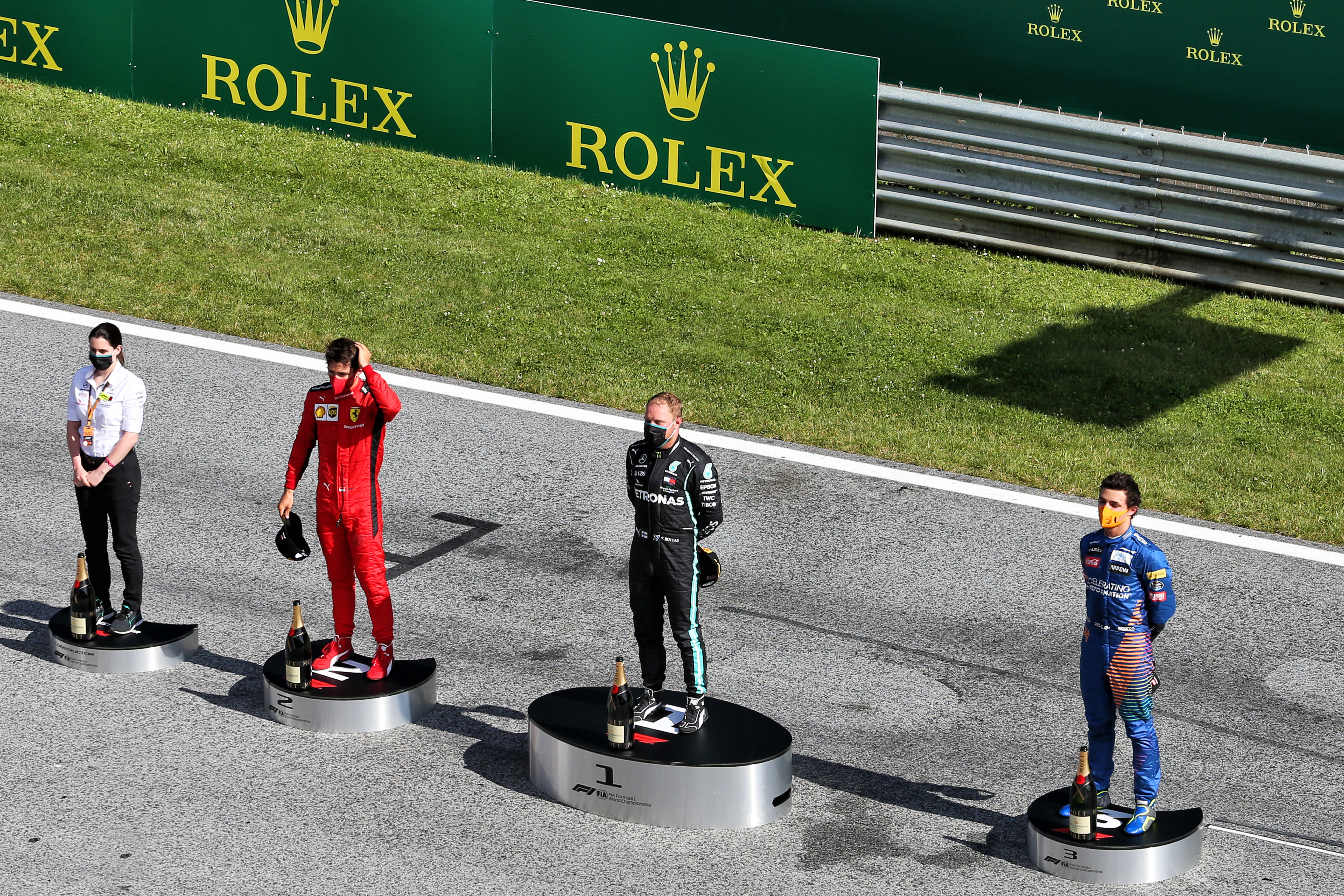
As it was, Leclerc and Norris filled the official podium, given that Hamilton took a 5s penalty for his part in a collision with Alex Albon.
With a grand prix victory tantalisingly feasible – he was on way faster tyres than both Mercedes and right behind them thanks to an opportunely-timed safety car – Albon tried a brave round-the-outside pass on Hamilton that momentarily looked to have worked. Then Hamilton’s front left hit Albon’s right-rear and spun the Red Bull into the gravel.
That was just one more drama in Mercedes’ weekend, which started with Red Bull’s DAS protest but didn’t end when Mercedes’ steering innovation was declared legal on Friday evening.
The Red Bull Ring is a particularly punishing venue to bring a field of unraced new cars to, the kerbs shaking suspensions, wings – and electrical components – to the very edge. The Mercedes W11 was the fastest thing around, 0.5s clear of the rest, but fragile.
Even Friday running revealed a problem with an electronic sensor for the gearbox that was very worrying and for which there was no immediate solution other than minimising the vibrations that were wreaking havoc with the signals.
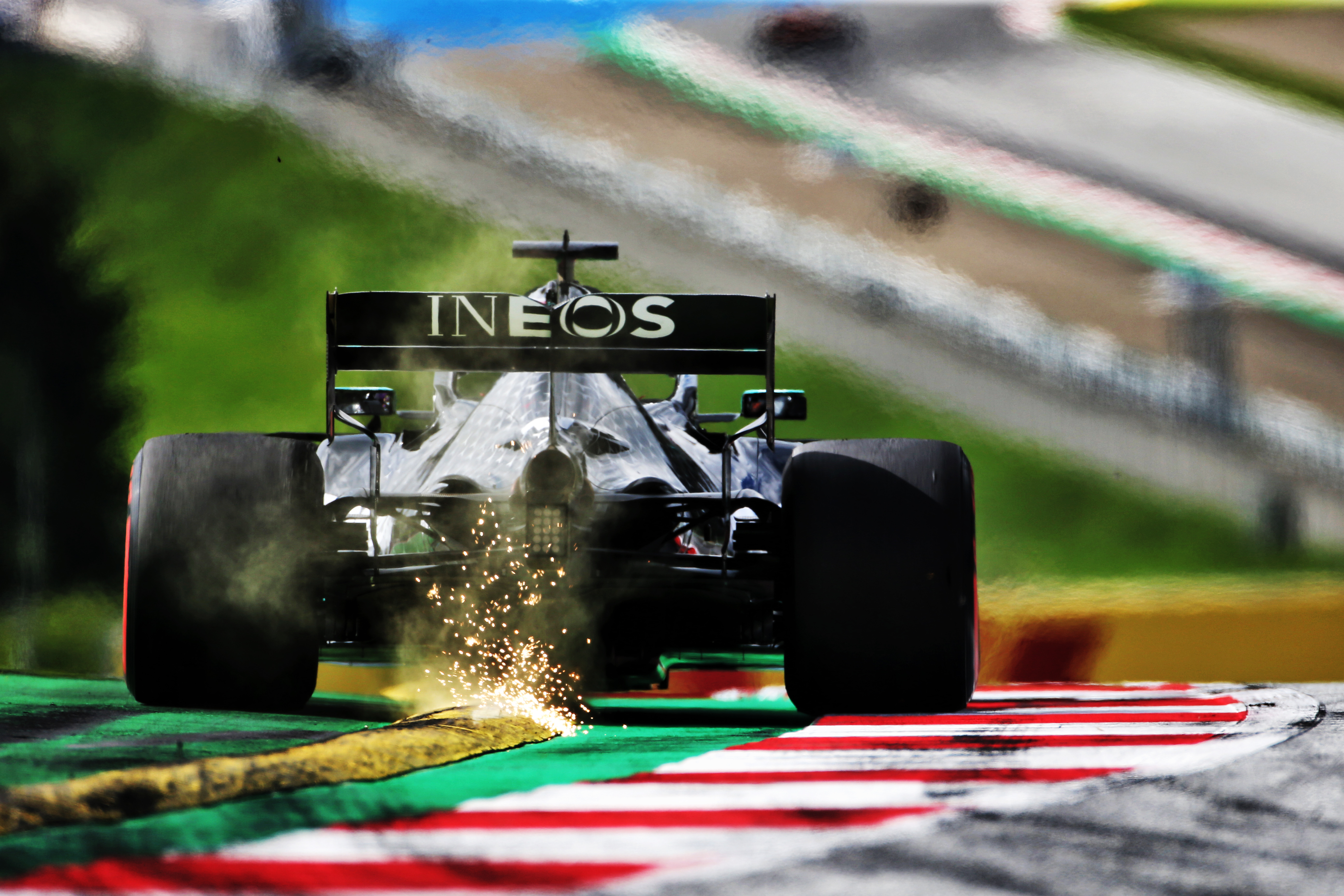
The kerbs here are brutal, but they need to be used to the full for a competitive lap time. It’s true that the Mercedes had enough of a pace advantage over the field that they could probably have locked out the front row even while keeping off the kerbs – but obviously that couldn’t happen, as there are two hyper-competitive drivers trying to beat each other.
Bottas’ first Q3 lap turned out to be the pole. On his final attempt he got wide on the Turn 4 exit, just a bit greedy with how early he released the car mid-corner, dusty track, kerb edge and gravel following in quick succession.
The yellows were briefly out, then back in again – as Bottas stayed on the grass, but the following Hamilton had technically committed a yellow flag offence in staying on it as he passed. After Red Bull presented the damning footage to the stewards on Sunday, so Hamilton was demoted three places to fifth.
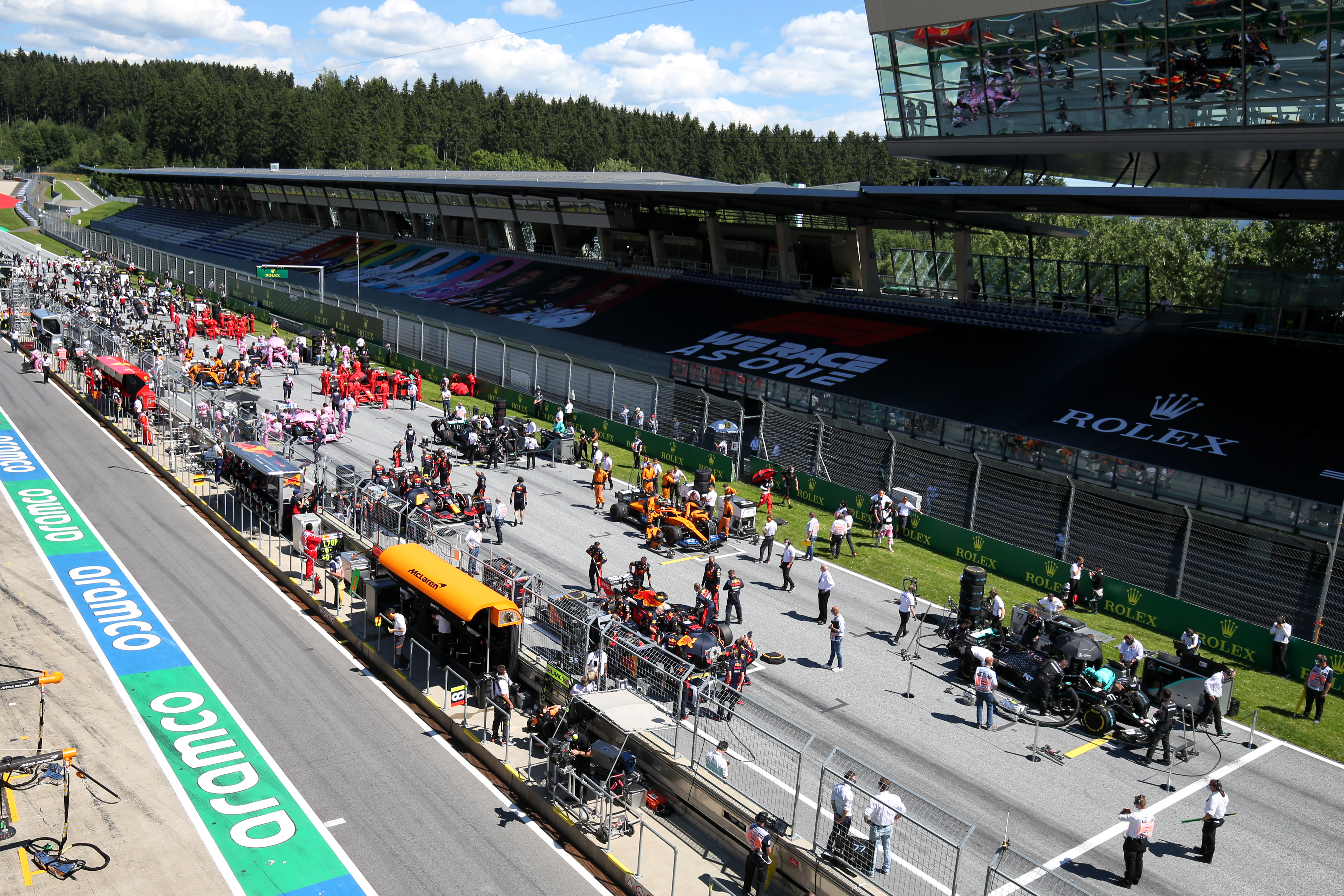
The most intriguing thing about that dramatic development was that it put Max Verstappen’s medium-shod Red Bull onto the front row. The only one in the top-10 not on the soft, was it possible that the medium would give him a strategy advantage over Mercedes?
It wasn’t definite, especially given the Mercedes’ significantly greater inherent pace – but it might. It was a scorching day at the beautiful Spielberg venue, track temperature nudging 53-degree C as the gantry lights went out at 3.10pm.
“He was just starting to get to the cliff with his tyres and I could see the gain I was making” :: Lewis Hamilton
The hotter the track, the worse the soft’s rear heat degradation would become. That was the theory, but it should still have been a faster tyre for the first 10 laps or so.
The picture was far from clear even as Bottas took off into a big lead as the rest of the pack squabbled behind. Verstappen held off the momentarily grippier soft-shod McLaren of Lando Norris for a few corners until the harder tyres came fully in, allowing Verstappen to ease himself out of Norris’ dicing range. Bottas was 2s ahead and out of DRS range even before the feature was enabled on the third lap.
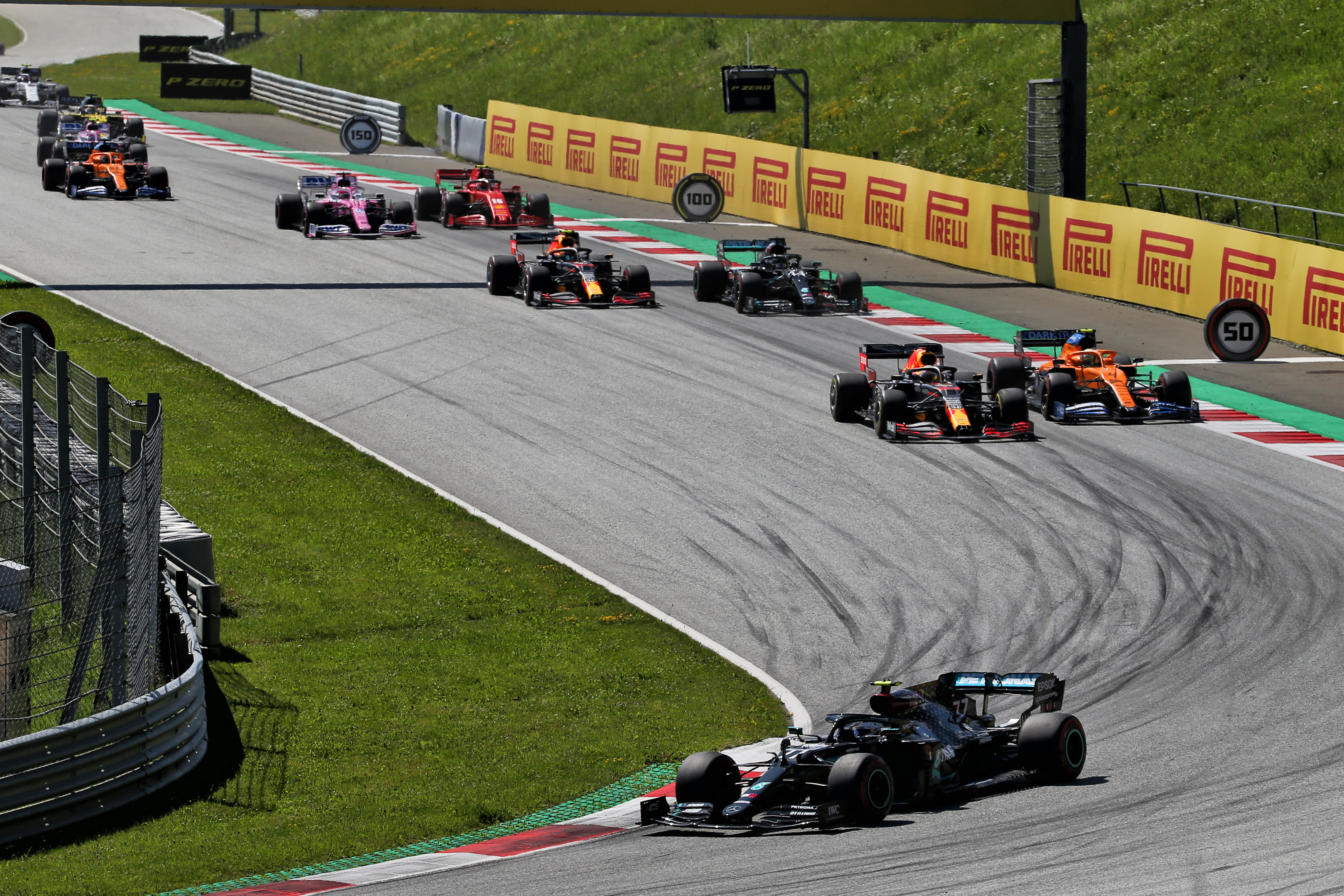
Just as Verstappen had held Norris out wide at Turn 1, so had Albon to Hamilton, with hard no-compromise conviction. Hamilton had instead breezed past the Red Bull on the second lap and Norris on the third, with Albon following the Mercedes past the McLaren.
The fastest four cars – the Mercedes and Red Bulls – were now in the top four positions. But Verstappen was hanging on to Bottas despite his initially-slower tyres, pegging the gap at just over 3s and keeping out of Hamilton’s reach for now.
But that intriguing strategy question was rendered null and void as the Honda suffered a major mechanical mishap on the 10th lap.
Which seemed to have distilled the race down to an intra-Mercedes contest. Could Hamilton do anything about Bottas? He was up for giving it a try. He halved the 8s gap over the next 13 laps as the pit stop window began to open.
Bottas reckoned he had it all under control.
“The gap I got at the beginning meant I could just manage the stint,” he said.
“From my point of view, the best thing to do for me to win the race was to go as long as possible, so I tried to manage quite a lot in the beginning and middle of the stint and towards the end I would have stepped up the pace. So everything was pretty much under control.”
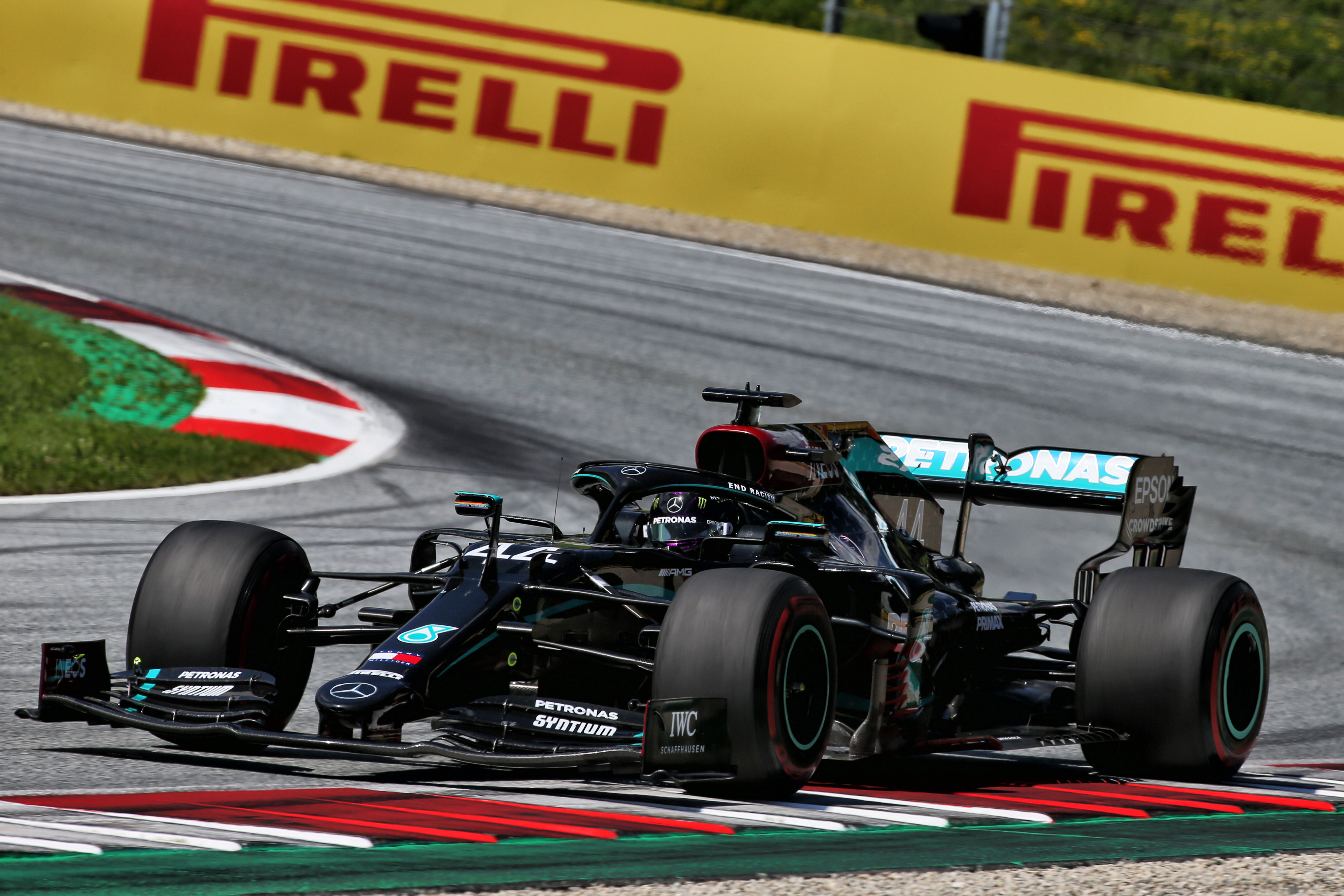
Hamilton saw it differently.
“He was just starting to get to the cliff with his tyres and I could see the gain I was making,” he said.
“I needed to get as close as possible… I was going to extend my stint as long as I could. The first car gets priority at the stops so my plan was to go as long as possible and then take the opposite tyre to him, to take a risk.”
That was another thing we didn’t get see play out because on the 26th lap Kevin Magnussen’s Haas – dicing in the lower half of the field with Esteban Ocon’s Renault – ran out of brakes at Turn 3 and pulled off to the side. It was suspected that debris in the ducts had caused a disc to oxidise into oblivion.
The race came under the safety car so as to move the Haas – and everyone pitted. This was about five laps short of Mercedes’ planned stop for the first car. Instead, Hamilton was guided into backing up to create the space for the Mercedes to be stacked in the pits. Both were fitted with a set of hards to get to the end, pretty much the standard choice.
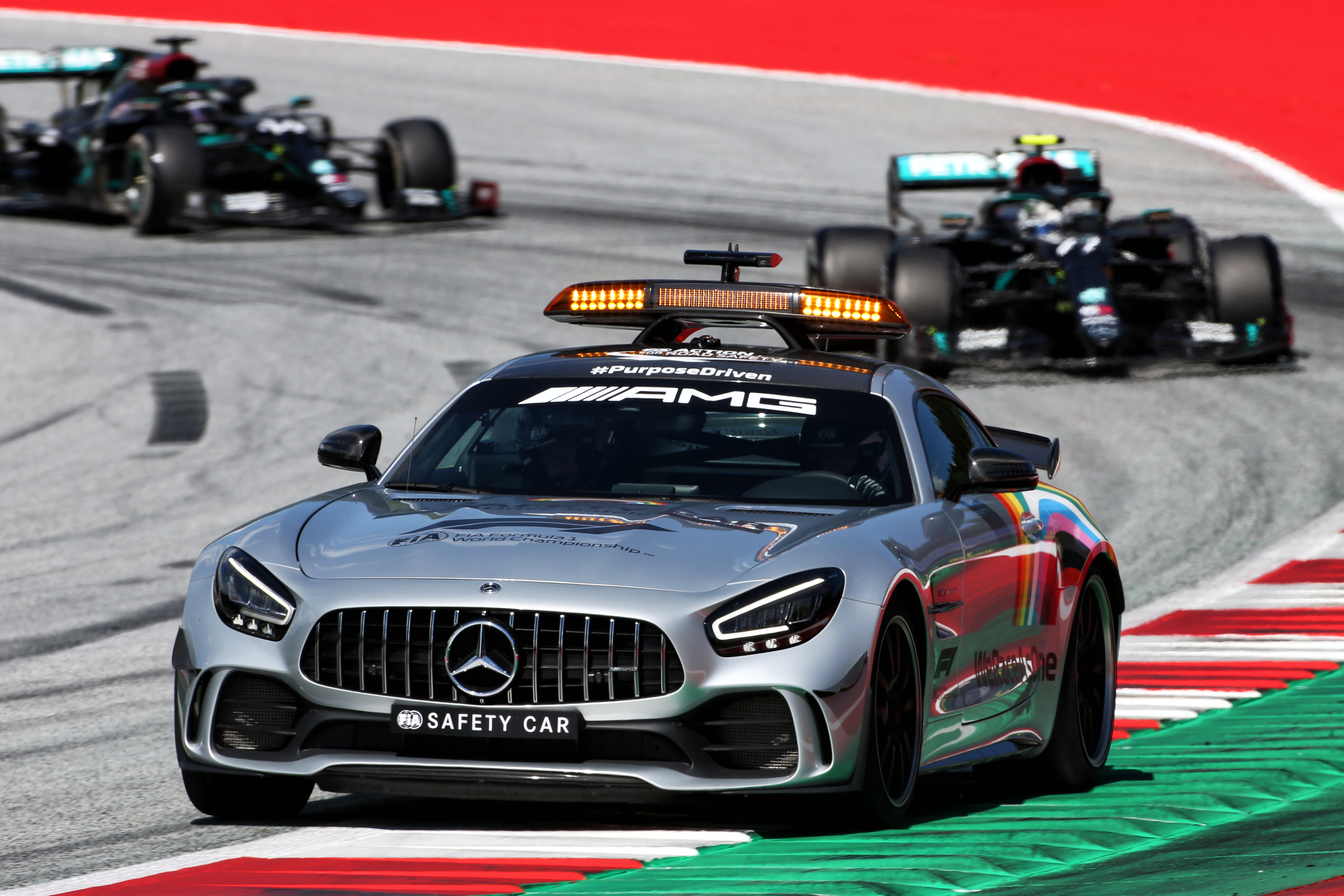
The ‘backing and stacking’ procedure meant Hamilton didn’t get a chance to enact his plan of prompting his tyre choice.
“I didn’t know what tyres were going on. I didn’t prompt it because the safety car meant other things came into play.” Hamilton’s plan of running significantly longer and then getting onto a different tyre had been scuppered by the safety car’s timing.
There were more issues than just the safety car interfering with strategy. Almost from the beginning the gearbox sensor issue became apparent on Bottas’ car. Shortly after, the same problem developed on Hamilton’s.
Soon the team would need to begin issuing radio instructions, telling them to stay off the kerbs, and the problem was revealed to the world.
Meantime they lined up behind the safety car in the order of Bottas, Hamilton, Albon, Norris, Sergio Perez (on mediums, uniquely), Charles Leclerc, Carlos Sainz Jr, Sebastian Vettel and the rest. Lance Stroll had been running directly ahead of Vettel, Daniel Ricciardo behind – but both had retired with a power loss and cooling issue respectively.
The safety car had wiped out Albon’s 15s deficit to the Mercedes, Norris having been a further 5s back from the Red Bull. But all were nicely bunched up again as racing recommenced on the 32nd lap of 71, the Mercedes drivers having been using their DAS systems to generate some front tyre heat on the prep lap.
They quickly built the gap over Albon up again and he in turn pulled away from the squabbling McLaren/Racing Point/Ferrari pack behind. The Racing Point’s pace was perhaps less exciting than the practices had suggested but Perez was holding his own.
Vettel crashed out of this group after clumsily hitting Sainz who was dicing with the other Ferrari of Leclerc. Seb had been having an awful time with the Ferrari from the second lap, barely able to keep it on track.

“I’m happy I spun only once,” he said. He rejoined at the back with body damage, and could make no significant progress from there.
The Mercedes radios were buzzing with instructions to stay off the kerbs. At one point James Vowles issued stern warnings to each driver in turn, after they’d traded fastest laps between them in their struggle. Amid this Hamilton was asking to retain his higher engine modes but was denied. “We are in worse shape than the other car,” Bottas was told.
“As far as I was concerned I’d completed the move. I was already looking down the road to Valtteri when I felt the bump” :: Alex Albon
There was a problem too with the Mercedes-powered Williams of George Russell, running a tidy race, having led the Alfa Romeos and Romain Grosjean’s Haas for a time, but suffering now with falling fuel pressure.
His pulling off to the side brought out a second safety car – at exactly the wrong moment for the Mercedes, which had just passed the pit entry road. There were 20 laps to go and Albon, the McLarens and Ferraris all pitted for fresh rubber – softs for Albon and the Ferraris, mediums for the McLarens.
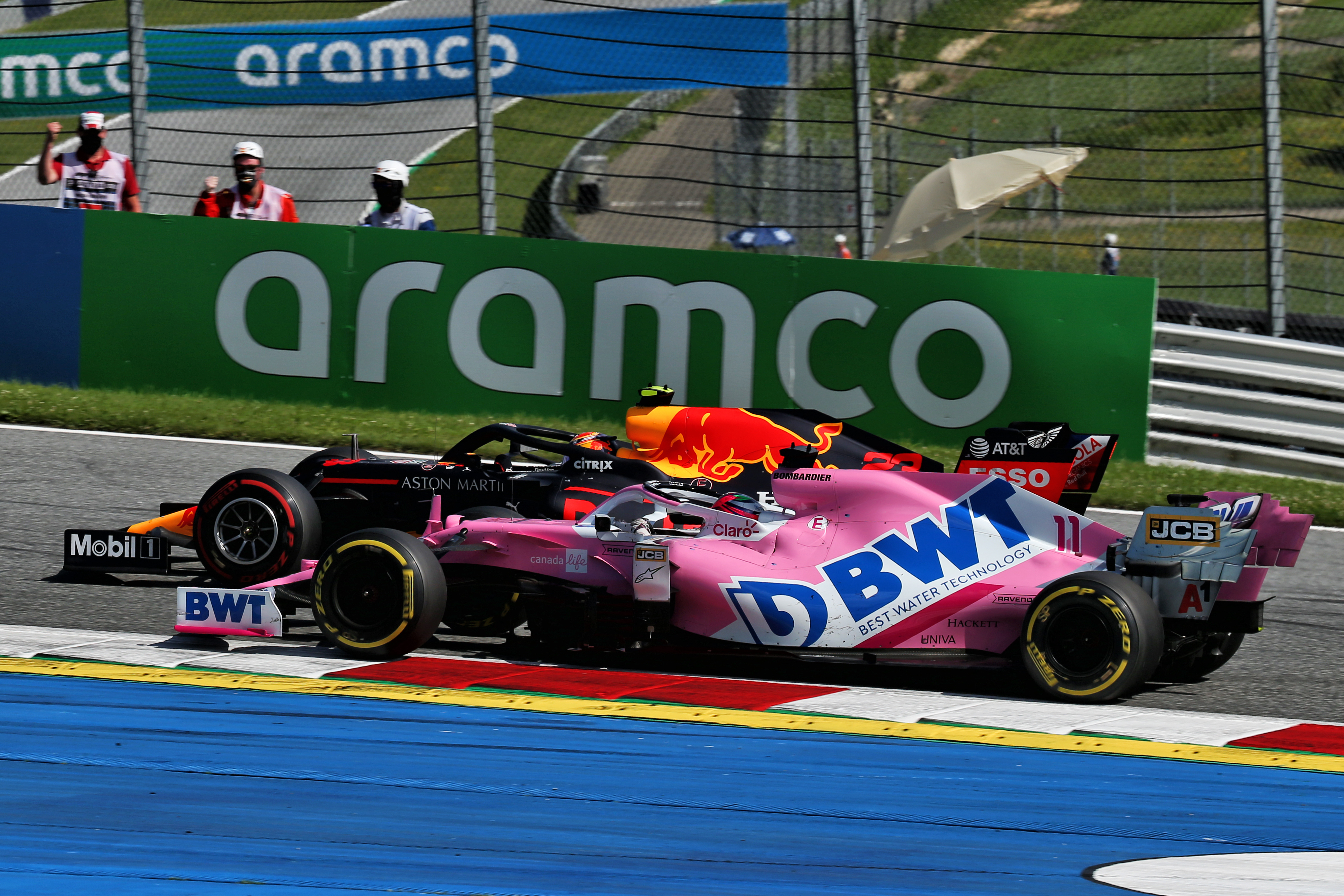
Staying out made Perez up a couple of places over Norris and Albon, but as racing resumed Albon was able to repass the Racing Point – at almost the exact moment there was another safety car. Kimi Raikkonen’s wheel had not been properly attached at his pitstop and it departed company with the car as he exited Turn 9.
Which set up the perfect scenario for Albon, on fresh softs and stacked right behind two Mercedes with 34 lap-old tyres by the time the safety car came in.
A first grand prix victory surely beckoned – but he had to make the moves quick, while the Mercedes would be struggling to bring the old rubber back up to temperature.
He was immediately all over Hamilton like a rash, dicing with him through Turn 3, slipstreaming him down to 4, forcing Hamilton to go defensive.
Albon went for the outside and with greater momentum hung on in there. He almost pulled it off.
“As far as I was concerned I’d completed the move,” he said later. “I was already looking down the road to Valtteri when I felt the bump.”
Hamilton’s left-front made contact with Albon’s right-rear, spinning the Red Bull into the gravel. He rejoined way down the field and would later pull off with a power loss – so maybe that would’ve happened anyway…
Hamilton’s 5s penalty for the incident made for an awkward situation, for the safety car had brought the intensely-dicing Leclerc/Norris/Sainz/Perez within possible 5s range. Leclerc was incisive in getting to the head of this pack, super-late but beautifully-judged moves under braking.
“It was one of my best drives,” he said. The Ferrari had no business being second. He was comfortably going to be able to stay within less than 5s of Hamilton, who was delayed by yellows.
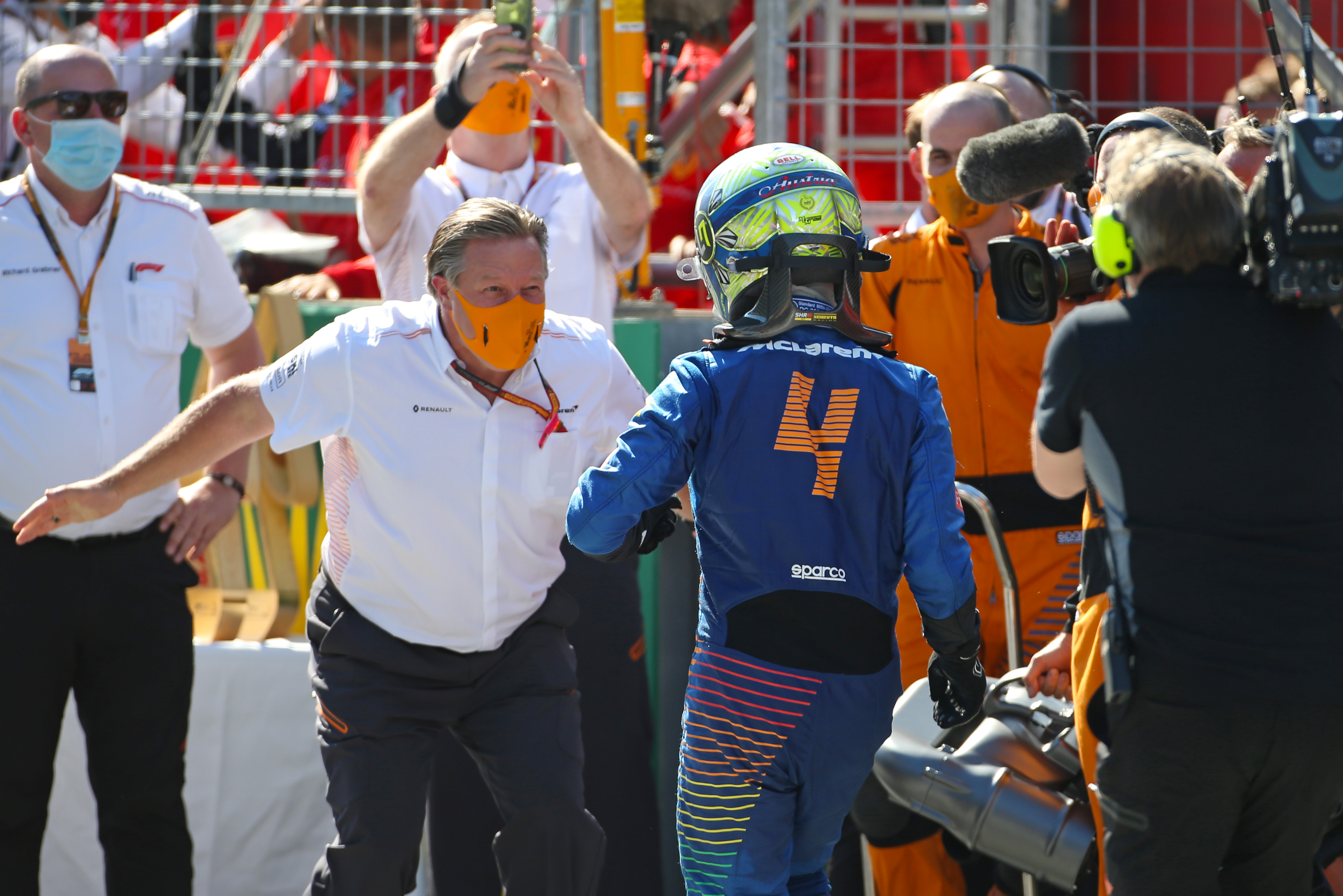
For Norris, it looked like he was going to fall just short. Going into the last lap he would need to set a faster lap than anyone had managed so far if he was to do it. Remarkably, he did exactly that – and just nailed third place on corrected time at the line.
Only 11 cars were still running at the end – and behind Perez’s sixth placed Racing Point were Pierre Gasly, Esteban Ocon, Antonio Giovinazzi, Vettel and Nicholas Latifi. The Mercedes had just about managed to survive – and it was a relieved Bottas who stepped out the car.
“I was struggling there at the safety cars. At any moment it could have lost me the race. We managed to dodge many bullets today.”







